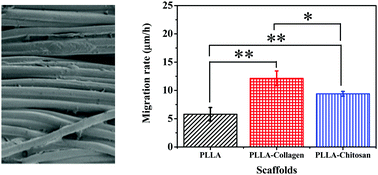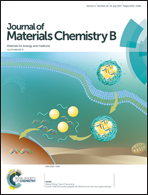Poly(l-lactide) melt spun fiber-aligned scaffolds coated with collagen or chitosan for guiding the directional migration of osteoblasts in vitro
Abstract
Aligned fiber scaffolds can mimic the parallel aligned fibrils in the extracellular matrix (ECM) of bones, and thus regulate many cellular behaviors. The aligned scaffolds are usually prepared by a microplate micropatterned method, freeze casting, evaporation, slip casting, ice-templating, plain weaving, and fiber forming techniques. In this study, the melt spinning technology, which has the advantages of a higher spinning speed, solvent-free processing and readily scalable production, was used to prepare poly(L-lactide) (PLLA) melt spun fibers with an average diameter of 70.3 ± 11.4 μm. The fibers were further bonded by 5% PLLA tetrahydrofuran solution to prepare PLLA spun fiber-aligned scaffolds. Collagen and chitosan molecules were coated onto the fibers/into the scaffolds to obtain multiple biochemical and surface aligned topography cues, respectively. The collagen or chitosan-coated PLLA aligned scaffolds could effectively improve the viability, adhesion, length and migration behaviors of osteoblasts in vitro. In particular, the collagen coated aligned scaffold had the largest cell length and the fastest migration rate, with a preferential direction along the fibers. This type of scaffold provides a versatile substrate to control cell behaviors, having great potential for bone regeneration.



 Please wait while we load your content...
Please wait while we load your content...